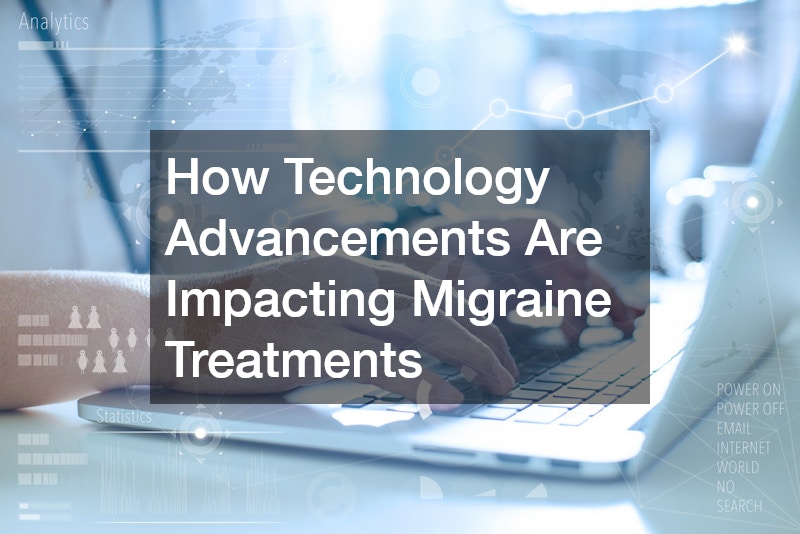This article explores how cutting-edge technological advancements are revolutionizing the migraine treatments, offering new hope and solutions for sufferers. By leveraging these innovations, patients can expect more individualized care, swifter relief, and preventative strategies to effectively manage their conditions.
What Are the Latest Technological Advancements in Migraine Treatments?
Use of Wearable Devices
Wearable technologies have emerged as a game-changer in migraine management, providing real-time monitoring capabilities. Devices like headbands and smartwatches are integrated with sensors that can track physiological markers related to migraines, such as blood flow and heart rate variability.
This innovation allows users to detect early signs of migraine attacks before they escalate. Consequently, wearable devices like Cefaly and others can also aid in providing immediate relief by deploying neuromodulation techniques.
By continuously gathering data, these devices help sufferers understand their triggers better, potentially reducing the frequency of attacks. As a result, patients can proactively manage their migraines with increased precision and efficacy.
Innovative Software Applications
Software applications have become essential tools in the personal management of migraines, offering a comprehensive platform for tracking and predicting migraine patterns. Apps like Migraine Buddy provide features like symptom tracking, logging triggers, and even predicting attacks using sophisticated algorithms.
Moreover, these applications facilitate a better patient-doctor interaction by maintaining a detailed headache diary. They empower users with data that reveals their migraine trends, which can be crucial for formulating effective treatment plans.
Some advanced algorithms in these apps can also provide early warnings to users, maximizing the window for preventative treatments or interventions. Thus, software applications significantly enhance the personal approach to managing migraines.
How Effective Are New Migraine Medications Enhanced by Technology?
Advances in Pharmaceutical Research
The field of pharmaceutical research has seen significant advancements with the integration of technology, leading to the development of new migraine medications such as CGRP inhibitors. These medications specifically target the proteins and receptors involved in migraine pathophysiology, offering better outcomes.
Furthermore, the incorporation of AI and big data analytics in drug research has expedited the development process for even more targeted therapies. By analyzing vast data sets, researchers can identify potential compounds faster and with more precision.
Such advancements mean that patients now have access to medications that are not only more effective but also have fewer side effects. Ultimately, these pharmaceutical innovations offer new horizons for migraine sufferers seeking effective relief.
Personalized Medication Plans
Personalized medicine is at the forefront of modern-day migraine treatment, facilitated by technological advancements. By analyzing genetic markers and phenotypic data, healthcare providers can tailor treatment plans to suit individual patient needs.
Biotechnology companies are increasingly using AI models to predict the best medication regimen for patients based on their unique biological makeup. This minimizes the trial-and-error approach often associated with migraine treatments.
Personalized medication plans have demonstrated considerable improvement in treatment efficacy, as they align closely with a patient’s specific needs and responses. Consequently, this individualized approach maximizes therapeutic outcomes while minimizing adverse effects.
Can Technology Help in Early Detection and Prevention of Migraines?
AI-Driven Diagnostics
AI-driven diagnostics are transforming the early detection and prevention of migraines, offering innovative ways to predict onset. By analyzing patterns in physiological data, AI models can forecast the likelihood of an upcoming migraine attack with remarkable accuracy.
These predictive analytics tools provide patients with the ability to take preemptive measures that may prevent full-blown attacks. In this way, AI is not just a diagnostic tool but also a proactive measure for migraine management.
A significant advantage of AI diagnostics is the increased personalized insights it provides, facilitating more precise preventive strategies.
Biofeedback and Neurofeedback Tools
Biofeedback and neurofeedback tools have proven to be effective in preventing migraines by training patients to control physiological processes. These tools measure functions like muscle tension and brainwave activity, providing real-time feedback to the users.
Through this feedback, patients learn to self-regulate stress and other bodily responses that typically trigger migraine episodes. Consequently, these tools not only reduce the frequency of attacks but also improve the patient’s overall well-being.
The integration of these technologies into regular migraine management plans offers a non-pharmacological approach to prevention, appealing to those looking to minimize medication intake.
What Role Does Telemedicine Play in Migraine Management?
Remote Consultations and Prescriptions
Telemedicine has revolutionized migraine management by providing remote consultations and prescriptions, offering easy access to healthcare for those affected by this condition. Patients can consult healthcare professionals from the comfort of their homes, minimizing the need for in-person visits.
This convenience is especially beneficial for sufferers with severe migraines that might make travel challenging. Moreover, remote consultations ensure that patients receive timely interventions, thus alleviating symptoms more effectively.
Patient Monitoring and Support
Telemedicine platforms are equipped with features that enhance patient monitoring and support, facilitating ongoing care management. These platforms allow healthcare providers to monitor patient progress and adjust treatment plans based on real-time data.
Continuous interaction through digital platforms keeps patients engaged and informed, contributing to improved health outcomes. Furthermore, these platforms often include peer support communities, offering patients a space to share experiences and advice.
Are There Any Risks or Challenges Associated with Technological Migraine Treatments?
Privacy Concerns
As digital health technologies become more integrated into migraine treatment, concerns about data privacy and security arise. The collection and storage of sensitive health information require robust security measures to prevent unauthorized access and breaches.
Patients must be assured that their data is handled with the utmost confidentiality and protected by stringent privacy regulations. Ensuring such protections is essential to building trust in technological solutions for migraine management.
Technological Accessibility
Despite the potential of advanced migraine technologies, accessibility remains a significant challenge. The cost of high-tech devices and platforms may limit access to those who need them most.
Additionally, disparities in technology literacy can impede the effective use of these tools, particularly among older populations. Tailored educational programs can help bridge this gap, ensuring broader access to modern solutions.
.

